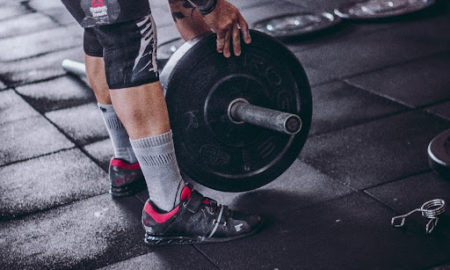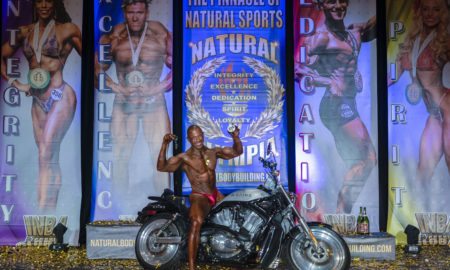This article is a response to Ron Harris’ “Machines Are Gravy,” which appeared in the August ’09 IRON MAN. My experience with and conclusions about Nautilus machines and free weights were precisely the opposite of his. Indeed, my 40 years of experience with Nautilus machines overwhelmingly supports my conclusion.
I have no delusions that my training results or those from the hundreds—perhaps, more accurately, thousands—of trainees who have learned about the benefits of honest, scientifically based exercise will ever be featured in major muscle magazines. Trainees like me couldn’t care less about the drug-enhanced mesomorphs who dominate a drug-infested sport; their personal goals are antithetical to the goals of seeking maximum strength, overall health and improved quality of life. I say that as a contributor to IRON MAN and similar journals for more than 30 years. I was personally involved with the IFBB in an administrative capacity for a decade, served as head judge of the professional division and judged several Mr. and Ms. Olympia competitions.
Mr. Harris compares Nautilus machines to gravy. Yet when properly used—which, in most cases, is never—Nautilus machines yield the most stimulating, efficient and by far safest way for everyone to train. Too strong a statement? Not when the cause and effect of progressive exercise are understood.
For those of us who came of age in the 1960s, the only controversy surrounding lifting weights was whether to do it. Most coaches, let alone parents, defaulted to stereotypes, relegating weight training to narcissists of the nth degree or men with mere emptiness above their foreheads. Not to be restricted by the stereotypes, I struck out on my own, and my first step along the winding road to orthopedic disaster was a hastily researched fascination with Olympic lifting—which, at the time, consisted of the press, snatch and clean and jerk. As a 160-pound enthusiast who had no formal instruction, I became (through sheer determination if nothing else) competitive with official lifts of 225, 225 and 275—somewhat pathetic for a middleweight by national standards but medalworthy at the collegiate level. I sensed trouble when persistent, eventually chronic lumbar pain and later X-rays detected major degeneration in my spine. Improper lifting technique? Orthopedic change inherent in quick lifts? Possibly a combination of both. In any case, I thought it best to move on to other modes of strength training, which led me to powerlifting, or from the proverbial frying pan to the fire.
For the second time I leapt into the fray, without research, let alone any understanding of the concept of force and structural integrity. I was to learn, again far too late, that when imposed force exceeds structural integrity, injury must occur. Another case of improper technique? Anything is possible, but this time I correctly determined that the neurological trauma I was experiencing down my right arm was a consequence of the 400-pound-plus barbell resting on my cervical spine. (Stick with me: I’m establishing my ignorance to help build my orthopedic argument.) I was thus forced by design, if not necessarily passion, to give serious thought to a commonsense training idea—that a set of 10 repetitions might be a smarter way of going forward.
It was—if for no other reason than my evolving understanding of what I was spending an inordinate amount of time on—safer, but I was in most respects still on the wrong track. Yes, I did understand, finally, that some specific exercises were better than others at stimulating a positive response. After trial and error, I found that the basic exercises worked best for me. The exact routine was squats, overhead presses, chinups, bench presses, bent-over rows, barbell curls and parallel-bar dips—all for three sets of 10, with the exception being squats, which I did for up to 20 reps. The results were tangible and got noticed.
Still, there were specific problems. Even high-rep squats, as opposed to singles, compressed my cervical spine. Overhead presses and rows compromised my lower back. Chins worked the biceps before fully working the lats. Likewise, dips fatigued the triceps long before the shoulders and the pecs. The paradigm of three sets led to a gradual “pacing” of the workout, instead of the necessary progression, and none of the exercises worked any muscle meaningfully in the contracted position.
Enter Arthur Jones.
Intrigued by the initial Iron Man article titled the “Upper-Body Squat,” I took my time and tried to thoroughly understand what the man was talking about, which went quite a bit further than “sets and reps.” Then I put Jones’ principles into practice. Unlike Ron Harris—and, unfortunately, many, many others—I never looked back. I stimulated more muscular gains in six months than I had in all of my sincere but poorly thought-out past. With guidance from Jones, meaningful, scientific exercise finally made sense to me. Jones offered the entire field the first and still the only scientific approach to progressive-strength training. Incorporating preexhaustion, machine-based training was the key breakthrough to efficient, safe, productive exercise.
Think about the concept clearly: Strict isolated exercise (as nearly as is possible to isolate a bodypart, anyway), which in most exercises can be efficiently accomplished only by using a Nautilus machine, immediately followed by a compound movement, will work the targeted bodypart more intensely and safely than any other form of training that I’m familiar with. Isolating a bodypart for work is even more efficient these days with MedX machines.
I also want to emphasize high intensity and low force, the preferred paradigm for those who view training as a lifelong endeavor. On a machine it can be practiced with a confidence that physical potential can be realized and the threat of injury minimized. Sadly, that advanced protocol is rarely practiced and seems never to have been fully understood. Those who, like me, have experienced the experience, however, also never look back.
That protocol works thoroughly with every muscular structure. Natural bodybuilders must grasp the fact that when muscular systems are stimulated to respond, it is the rest following the stimulus that permits the stimulus to take effect. I specify natural because drug-enhanced bodybuilding will in the short term respond to virtually any stimulus.
What cannot be overstated, of course, is that the genetically gifted, with their long muscle bellies and short tendons, will have superior response regardless of the tool, protocol, exercise form, intensity, etc. Failure to mention that has long been the M.O. of commercial interests looking to seduce enthusiasts into believing that with supreme effort anyone can become a modern-day superman. Supreme effort certainly is a prerequisite to realizing one’s own physical potential, the ultimate goal; however, comparing one individual to the next is futile because of the uneven genetic playing field.
Arthur Jones invented exercise machines according to the functions of the muscles. He was the first to explain that the strength of a muscle varied, often significantly, throughout its full range of motion—thus the need for variable resistance. He pointed out, correctly, that all of the available fibers could be worked only in the contracted position—thus the need for meaningful resistance in the fully contracted position, a resistance not provided by the great majority of barbell exercises.
Jones also taught the need for direct exercise. With standard compound barbell movements, smaller muscles will fail before you can work a larger target area as thoroughly as possible. Heavy rows and presses, two of the best conventional exercises targeting the upper back and shoulders, are compromised by the weaker biceps and triceps. If, however, Nautilus pullovers precede the rows, following the function of the lats by drawing the humerus down past the torso, and are worked to failure, your lats will be totally fatigued. Now, immediately perform your rows. For a very brief time—mere seconds—the smaller biceps muscles will be stronger than the larger, fatigued lats, and you can bring additional fibers into play with the compound movement that you can get at in no other way.
After completing those two sets, you’ll feel a pump you’ve never before felt—accomplished thoroughly and safely, with high intensity and low force, the best of both worlds. To ensure even more safety, substitute seated machine rows with chest support for the bent-over rows. Your lower back will thank you. Performing strict lateral raises before overhead presses will have the same effect, isolating the delts and then bringing in the assistance muscles of the triceps and pecs intensely and quickly. One more example? Try doing a set of 15 strict leg extensions, followed immediately by a 15-rep set of squats. You may never forget those five minutes. Your thighs will have been worked harder than you can imagine, and since you’ll be forced to lessen the resistance on the squats, you will have again taken intensity to unprecedented levels while lowering the force on your spine.
Jones questioned the wisdom of the “super workouts,” high-volume workouts that often approached several hours a day, sometimes seven days a week. He instead recommended the least amount of exercise that stimulates the desired results. Brief, intense whole-body workouts twice a week—hard workouts where every exercise is taken to failure. No split routines, no three sets of 10, no talking between sets and letting the heart rate fluctuate up and down. Instead, one set to failure, moving from one exercise to the next, physically and mentally demanding, making fewer inroads into recovery ability and taking more time to grow. Consider the wisdom. Never again the need for standard cardiovascular work. Muscles, bones, heart and lungs thoroughly worked in the same session. If Nautilus machines are used with meaningful resistance, provided you use a full range of motion, you can obtain high degrees of flexibility. You’ve got full functional ability in one workout.
The current state of the art of fitness is, in my opinion, pitiful. The junk science trends governing training under the guise of “functional training” and consisting of “explosive training,” “plyometrics,” “stability training” and other equally ridiculous terms will, in the long run, not build stronger, faster athletes but will instead produce injured, potentially crippled athletes, either acutely or, most likely, chronically. Joint stress accumulates silently.
Arthur Jones delivered the message 40 years ago: Train hard, but train smart. High intensity, low force, exemplified in its ultimate potential with the proper use of Nautilus machines. Ignore it at your peril.
Editor’s note: We will have an interview with Roger Schwab in a future issue of IRON MAN. IM
















You must be logged in to post a comment Login